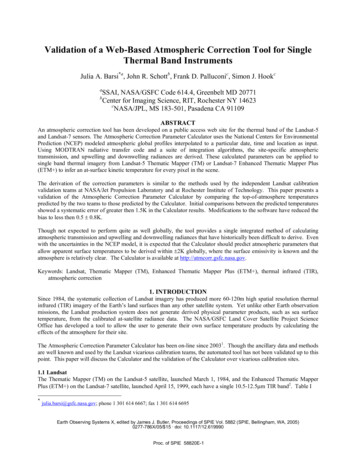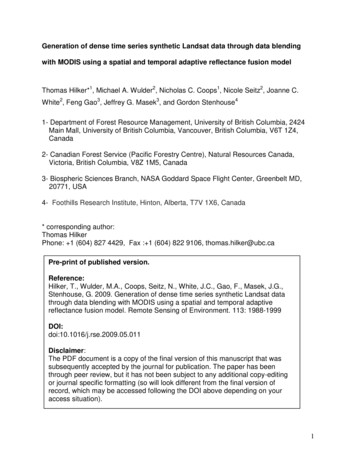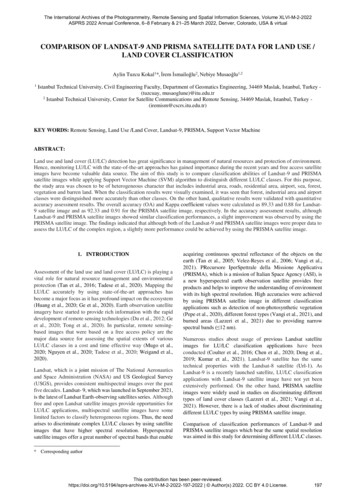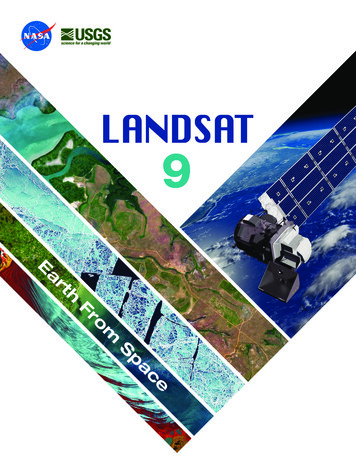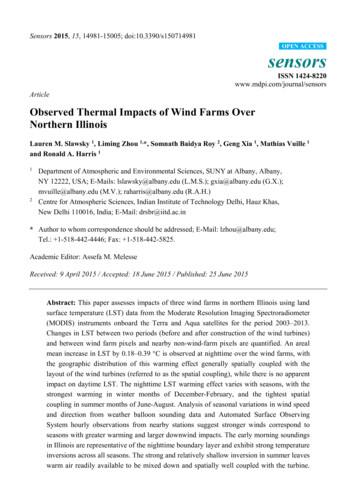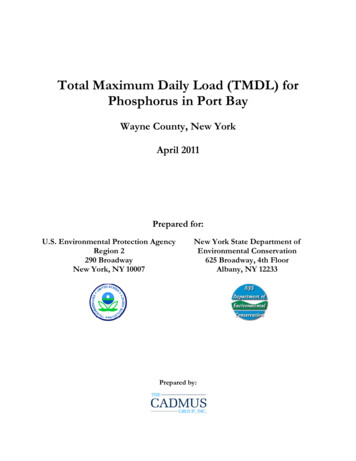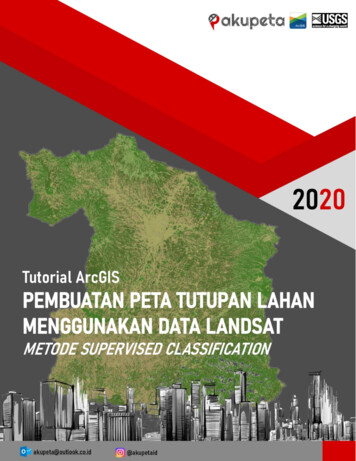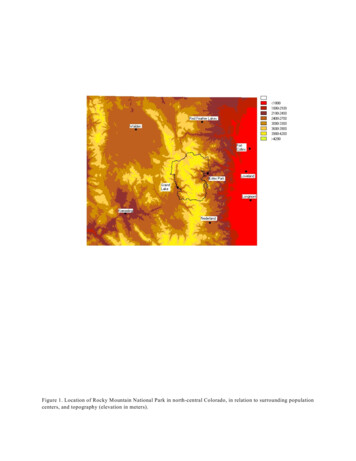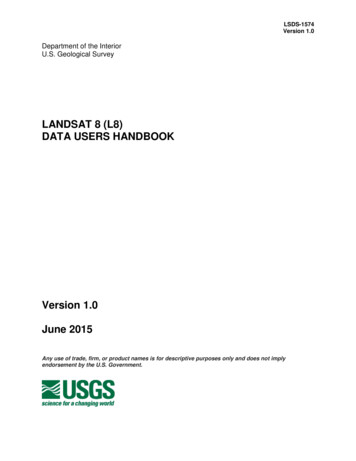
Transcription
LSDS-1574Version 1.0Department of the InteriorU.S. Geological SurveyLANDSAT 8 (L8)DATA USERS HANDBOOKVersion 1.0June 2015Any use of trade, firm, or product names is for descriptive purposes only and does not implyendorsement by the U.S. Government.
LANDSAT 8 (L8)DATA USERS HANDBOOKJune 2015Approved By:K. ZanterDateLSDS CCB ChairUSGSEROSSioux Falls, South Dakota- ii -LSDS-1574Version 1.0
Executive SummaryThe Landsat 8 Data User’s Handbook is a living document prepared by the U.S.Geological Survey Landsat Project Science Office at the Earth Resources Observationand Science (EROS) Center in Sioux Falls, SD and the NASA Landsat Project ScienceOffice at NASA's Goddard Space Flight Center in Greenbelt, Maryland. Its purpose is toprovide a basic understanding and associated reference material for the Landsat 8observatory and its science data products. In doing so, this document does not includea detailed description of all technical details of the Landsat 8 mission, but focuses onthe information needed by the users to gain an understanding of the science dataproducts.The Landsat 8 Data User’s Handbook includes various sections that provide anoverview of reference material and a more detailed description of applicable data userand product information. This document describes the background for the Landsat 8mission as well as previous Landsat missions (Section 1) before providing acomprehensive overview of the current Landsat 8 observatory, including the spacecraft,both the OLI and TIRS instruments and the Landsat 8 concept of operations (Section 2).The document then includes an overview of radiometric and geometric instrumentcalibration as well as a description of the observatory component reference systemsand the calibration parameter file (Section 3), followed by a comprehensive descriptionof Level 1 Products and product generation (Section 4). Addressed next is theconversion of DNS to physical units (Section 5) and finally, an overview of data searchand access using the various on-line tools (Section 6). The applicable referencematerials are included at the along with the list of known issues associated with Landsat8 data (Appendix A) and an example of the Level-1 product metadata (Appendix B).This document is controlled by the LSDS Configuration Control Board (CCB). Pleasesubmit changes to this document, as well as supportive material justifying the proposedchanges, via a Change Request (CR) to the Process and Change Management Tool.- iii -LSDS-1574Version 1.0
Document eChangeNumberLSDS-1574Version 1.0June 2015CR 12286- iv -LSDS-1574Version 1.0
ContentsExecutive Summary . iiiDocument History . ivContents . vList of Figures . viiList of Tables . viiiSection 1Introduction . 11.1Foreword . 11.2Background . 21.2.1Previous Missions . 21.2.2Operations & Management . 31.3Landsat 8 Mission . 41.3.1Overall Mission Objectives. 41.3.2System Capabilities . 41.3.3Global Survey Mission . 51.3.4Rapid Data Availability . 51.3.5International Ground Stations . 61.4Document Purpose . 61.5Document Organization . 6Section 2Observatory Overview . 72.1Concept of Operations . 72.2Operational Land Imager (OLI) . 82.3Thermal Infrared Sensor (TIRS). 122.4Spacecraft Overview . 142.4.1Spacecraft Data Flow Operations . 15Section 3Instrument Calibration. 173.1Radiometric Characterization and Calibration Overview . 173.1.1Instrument Characterization and Calibration . 193.1.2Pre-Launch . 213.1.3Post-Launch. 233.1.4Operational Radiometric Tasks . 243.2Geometric Calibration Overview . 263.2.1Collection Types . 293.2.2Pre-Launch . 293.2.3OLI Geodetic Accuracy Assessment. 303.2.4Sensor Alignment Calibration . 313.2.5Geometric Accuracy Assessment . 313.2.6OLI Internal Geometric Characterization and Calibration. 313.2.7TIRS Internal Geometric Characterization and Calibration . 333.2.8OLI Spatial Performance Characterization . 343.2.9OLI Bridge Target MTF Estimation . 343.2.10 Geometric Calibration Data Requirements . 353.3Calibration Parameters . 38-v-LSDS-1574Version 1.0
3.3.1Calibration Parameter File . 393.3.2Bias Parameter Files. 413.3.3Response Linearization Lookup Table File . 42Section 4Level 1 Products . 434.1Level 1 Product Generation . 434.1.1Overview . 434.1.2Level 1 Processing System. 434.1.3Ancillary Data . 454.1.4Data Products . 464.1.5Calculation of Scene Quality . 554.2Level 1 Product Description . 564.2.1Science Data Content and Format . 564.2.2Metadata Content and Format . 594.2.3Quality Assurance Band . 59Section 5Conversion of DNs to Physical Units . 615.1OLI and TIRS at Sensor Spectral Radiance. 615.2OLI Top of Atmosphere Reflectance . 615.3TIRS Top of Atmosphere Brightness Temperature . 625.4Unpacking Quality Assurance Band Bits . 625.5LandsatLook Quality Image (.png) . 64Section 6Data Search and Access . 666.1Earth Explorer (EE) . 666.2Global Visualization Viewer (GloVis) . 696.3LandsatLook Viewer . 70Appendix A Known Issues . 72A.1 TIRS Stray Light. 72A.2 Striping and Banding . 75A.3 SCA Overlaps . 79A.4 Oversaturation . 80A.5 Single Event Upsets. 81A.5.1Observatory Component Reference Systems. 82A.6 OLI Instrument Line-of-Sight (LOS) Coordinate System . 82A.7 TIRS Instrument Coordinate System . 83A.8 Spacecraft Coordinate System . 84A.9 Navigation Reference Coordinate System . 84A.10 SIRU Coordinate System . 85A.11 Orbital Coordinate System . 85A.12 ECI J2000 Coordinate System . 86A.13 ECEF Coordinate System . 87A.14 Geodetic Coordinate System . 88A.15 Map Projection Coordinate System . 89Appendix B Metadata File (MTL.txt) . 90References . 95- vi -LSDS-1574Version 1.0
List of FiguresFigure 1-1. Continuity of Multispectral Data Coverage Provided by Landsat Missions . 3Figure 2-1. Illustration of Landsat 8 Observatory . 7Figure 2-2. OLI Instrument . 8Figure 2-3. OLI Signal-To-Noise (SNR) Performance at Ltypical . 10Figure 2-4. OLI Focal Plane . 11Figure 2-5. Odd/Even SCA Band Arrangement . 11Figure 2-6. TIRS Instrument with Earthshield Deployed. 12Figure 2-7. TIRS Focal Plane . 13Figure 2-8. TIRS Optical Sensor Unit . 14Figure 3-1. Simulated OLI Image of the Lake Pontchartrain Causeway (left) andInterstate-10 Bridge (right) Targets in WRS 022/039 . 35Figure 4-1. LPGS Standard Product Data Flow . 44Figure 4-2. Level 1 Product Ground Swatch and Scene Size . 46Figure 4-3. A Diagram of the First Pass ACCA Algorithm . 52Figure 4-4. A Temperate Region Affected by Cirrus . 54Figure 4-5. Landsat 8 Spectral Bands and Wavelengths compared to Landsat 7 ETM . 57Figure 4-6. Quality Band (BQA.TIF) displayed for Landsat 8 Sample Data (Path 45 Row30) Acquired April 23, 2013 . 60Figure 5-1. Landsat Look "Quality" Image (QA.png) displayed as .jpg for reference onlyLandsat 8 sample data Path 45 Row 30 Acquired April 23, 2013 . 65Figure 6-1. EarthExplorer Interface . 67Figure 6-2. EarthExplorer Landsat Data Sets. 67Figure 6-3. EarthExplorer Results - Browse Image Display . 68Figure 6-4. EarthExplorer Results Controls . 68Figure 6-5. Global Visualization Viewer (GloVis) Interface . 69Figure 6-6. The LandsatLook Viewer . 70Figure 6-7. Display of Landsat Imagery. 71Figure 6-8. LandsatLook Viewer screen display. . 71Figure A-1. TIRS Image of Lake Superior Showing Apparent Time-Varying Errors . 73Figure A-2. TIRS Special Lunar Scan to Characterize the Stray Light Issue. 74Figure A-3. Thermal Band Errors (left group) Prior to Calibration Adjustment and (rightgroup) After Calibration Adjustment . 75Figure A-4. Striping and Banding Observed in Band 1 (CA Band) . 76Figure A-5. Striping and Banding observed in Band 2 (Blue) . 77Figure A-6. Striping and Banding observed in TIRS Band 10 . 78Figure A-7. SCA Overlap Visible in Band 9 (Cirrus Band) . 79Figure A-8. SCA Overlap Visible in TIRS Band 10 . 80Figure A-9. Oversaturation Example in OLI SWIR Bands 6 & 7 . 81Figure A-10. Example of SEU Event Measured by OLI – SEU Manifests as a Line ofSingle-Frame Bright Spots . 82Figure A-11. OLI Line-of-Sight Coordinate System . 83Figure A-12. TIRS Line-of-Sight Coordinates . 84- vii -LSDS-1574Version 1.0
Figure A-13. Orbital Coordinate System. 86Figure A-14. Earth-Centered Inertial (ECI) Coordinate System . 87Figure A-15. Earth-Centered Earth Fixed (ECEF) Coordinate Systems . 88Figure A-16. Geodetic Coordinate System . 89List of TablesTable 1-1. Comparison of Landsat 7 and Landsat 8 Observatory Capabilities . 5Table 2-1. OLI and TIRS Spectral Bands Compared to ETM Spectral Bands . 9Table 2-2. OLI Specified and Performance Signal-to-Noise (SNR) Ratios Compared toETM Performance . 10Table 2-4. TIRS Noise-Equivalent-Change-in Temperature (NEΔT) . 13Table 3-1. Summary of Calibration Activities, Their Purpose, and How Measurementsare Used in Building the Calibration Parameter Files . 19Table 3-2. Summary of Geometric Characterization and Calibration Activities . 29Table 4-1. Standard: Ls8ppprrrYYYYDDDGGGVV FT.ext . 58Table 4-2. Compressed: Ls8ppprrrYYYYDDDGGGVV.FT.ext . 58Table 5-1. Bits Populated in the Level 1 QA Band . 62Table 5-2. A Summary of Some Regularly Occurring QA Bit Settings . 64Table 5-3. Bits and Colors Associated with LandsatLook Quality Image. 65Table A-1. TIRS Band Variability . 75- viii -LSDS-1574Version 1.0
Section 11.1IntroductionForewordThe Landsat Program has provided over 42 years ofcalibrated high spatial resolution data of the Earth'ssurface to a broad and varied user community, includingagribusiness, global change researchers, academia, stateand local governments, commercial users, nationalsecurity agencies, the international community, decisionmakers, and the general public. Landsat images provideinformation meeting the broad and diverse needs ofbusiness, science, education, government, and nationalsecurity.The mission of the Landsat Program is to provide repetitiveacquisition of moderate-resolution multispectral data of theEarth's surface on a global basis. Landsat represents theonly source of global, calibrated, moderate spatialresolution measurements of the Earth's surface that arepreserved in a national archive and freely available to thepublic. The data from the Landsat spacecraft constitute the longest record of the Earth'scontinental surfaces as seen from space. It is a record unmatched in quality, detail,coverage, and value.The Landsat 8 observatory offers these features: Data Continuity: Landsat 8 is the latest in a continuous series of land remote sensing satellites that began in 1972.Global Survey Mission: Landsat 8 data systematically builds and periodicallyrefreshes a global archive of sun-lit, substantially cloud-free images of the Earth'slandmass.Free Standard Data Products: Landsat 8 data products are available through theUSGS EROS Center at no charge.Radiometric and Geometric Calibration: Data from the two sensors, theOperational Land Imager (OLI) and the Thermal Infrared Sensor (TIRS), arecalibrated to better than 5% uncertainty in terms of top-of-atmosphere reflectanceor absolute spectral radiance, and having an absolute geodetic accuracy betterthan 65 meters circular error at 90% confidence (CE 90).Responsive Delivery: Automated request processing systems provide productselectronically within 48 hours of order (nominally much faster).The continuation of the Landsat Program is an integral component of the U.S. GlobalChange Research Program and will be used to address a number of science priorities,such as land cover change and land use dynamics. Landsat 8 is part of a global-1-LSDS-1574Version 1.0
research program known as NASA’s Science Mission Directorate, a long-term programthat is studying changes in Earth's global environment. In the Landsat Program tradition,Landsat 8 continues to provide critical information to those who characterize, monitor,manage, explore, and observe the land surfaces of Earth over time.The U.S. Geological Survey has a long history as a national leader in land cover andland use mapping and monitoring. Landsat data, including Landsat 8 and archiveholdings, are essential for USGS efforts to document the rates and causes of land coverand land use change, and to address the linkages between land cover and usedynamics on water quality and quantity, biodiversity, energy development, and manyother environmental topics. In addition, the USGS is working toward the provision oflong-term environmental records that describe ecosystem disturbances and conditions.1.2BackgroundThe Land Remote Sensing Policy Act of 1992 (U.S. Code Title 15, Chapter 82) directedthe federal agencies involved in the Landsat program to study options for a successormission to Landsat 7, ultimately launched in 1999 with a five-year design life, thatmaintained data continuity with the Landsat system. The Act further expressed apreference for the development of this successor system by the private sector as longas such a development met the goals of data continuity.The Landsat 8 project suffered several setbacks in its attempt to meet these datacontinuity goals. Beginning in 2002, three distinct acquisition and implementationstrategies were pursued: (1) purchase of observatory imagery from a commerciallyowned and operated satellite system partner (commonly referred to as a government“data buy”), (2) flying a Landsat instrument on NOAA’s NPOESS series of satellites, and(3) finally selection of a “free-flying” Landsat satellite. Considerable delays to Landsat 8implementation were incurred as a result. The matter wasn’t resolved until 2007 when itwas determined that NASA would procure the next mission space segment and theUSGS would develop the ground system and operate the mission after launch.The basic Landsat 8 requirements remained consistent through this extended strategicformulation phase of mission development. The 1992 Land Remote Sensing Policy Act(U.S. Code Title 15, Chapter 82) established data continuity as a fundamental goal anddefined continuity as providing data “sufficiently consistent (in terms of acquisitiongeometry, coverage characteristics, and spectral characteristics) with previous Landsatdata to allow comparisons for global and regional change detection andcharacterization.” This direction has provided the guiding principal for specifyingLandsat 8 requirements from the beginning with the most recently launched Landsatsatellite, Landsat 7, serving as a technical minimum standard for system performanceand data quality.1.2.1 Previous MissionsLandsat satellites have been providing multispectral images of the Earth continuouslysince the early 1970's. A unique 42 year data record of the Earth's land surface nowexists. This unique retrospective portrait of the Earth's surface has been used across-2-LSDS-1574Version 1.0
disciplines to achieve improved understanding of the Earth's land surfaces and theimpact of humans on the environment. Landsat data have been utilized in a variety ofgovernment, public, private, and national security applications. Examples include landand water management, global change research, oil and mineral exploration,agricultural yield forecasting, pollution monitoring, land surface change detection, andcartographic mapping.Landsat 8 is the latest satellite in this series. The first was launched in 1972 with twoEarth-viewing imagers - a return beam vidicon (RBV) and an 80-meter 4-bandmultispectral scanner (MSS). Landsat 2 and 3, launched in 1975 and 1978 respectively,were configured similarly. In 1984, Landsat 4 was launched with the MSS and a newinstrument called the Thematic Mapper (TM). Instrument upgrades included improvedground resolution (30 meters) and 3 new channels or bands. In addition to using anupdated instrument, Landsat 4 made use of the multi-mission modular spacecraft(MMS), which replaced the Nimbus based spacecraft design employed for Landsats 13. Landsat 5, a duplicate of Landsat 4, was launched in 1984 and returned scientificallyviable data for 28 years - 23 years beyond its 5-year design life. Landsat 6, equippedwith an additional 15-meter panchromatic band, was lost immediately after launch in1993.Finally, Landsat 7 was launched in 1999 and performed nominally until its scan linecorrector (SLC) failed in May 2003. Since that time, Landsat 7 continues to acquire tothis day useful image data in the “SLC off” mode. All Landsat 7 SLC-off data are of thesame high radiometric and geometric quality as data collected prior to the SLC failure.Figure 1-1 lists the continuity of multispectral data coverage provided by Landsatmissions beginning with Landsat 1 in 1972.Figure 1-1. Continuity of Multispectral Data Coverage Provided by LandsatMissions1.2.2 Operations & ManagementThe Landsat 8 management structure is composed of an ongoing partnership betweenNASA and USGS for sustainable land imaging. NASA contracted Ball Aerospace andTechnology Corporation to develop the Operational Land Imager and with Orbital-3-LSDS-1574Version 1.0
Sciences Corporation to build the spacecraft. The Thermal Infrared Sensor was built byNASA Goddard Space Flight Center. NASA was also responsible for the satellitelaunch and completion of a 90-day on-orbit check out before handing operations to theUSGS. The USGS was responsible for the development of the ground system and isresponsible for operation and maintenance of the observatory and the ground systemfor the life of the mission. In this role, the USGS captures, processes, and distributesLandsat 8 data and is responsible for maintaining the Landsat 8 data archive.The Landsat Project at the USGS Earth Resources Observation and Science (EROS)Center manages the overall Landsat 8 Mission Operations. In this capacity, USGSEROS directs on-orbit flight operations, implements mission policies, directs acquisitionstrategy, and interacts with International Ground Stations. USGS EROS capturesLandsat 8 data and performs pre-processing, archiving, product generation, anddistribution functions. USGS EROS also provides a public interface into the archive fordata search and ordering.1.3Landsat 8 MissionThe Landsat 8 mission objective is to provide timely, high quality visible and infraredimages of all landmass and near-coastal areas on the Earth, continually refreshing anexisting Landsat database. Data input into the system is sufficiently consistent withcurrently archived data in terms of acquisition geometry, calibration, coverage andspectral characteristics to allow for comparison of global and regional change detectionand characterization.1.3.1 Overall Mission ObjectivesLandsat 8 has a design lifetime of five years and carries 10 years of fuel consumables.The overall objectives of the Landsat 8 mission are: Provide data continuity with Landsats 4, 5, and 7.Offer 16-day repetitive Earth coverage, an 8-day repeat with a Landsat 7 offset.Build and periodically refresh a global archive of sun-lit, substantially cloud-free,land images.1.3.2 System CapabilitiesThe Landsat 8 system is robust, high performing, and of extremely high data quality.System capabilities include: Provides for a systematic collection of global, high resolution, multispectral data.Provides for a high volume of data collection. Unlike previous missions, Landsat8 far surpasses the average collection of 400 scenes per day. Landsat 8routinely surpasses 650 scenes per day imaged and collected in the USGSarchive.Uses cloud cover predicts to avoid acquiring less useful data.Ensures all data imaged are collected by a U.S. ground station.-4-LSDS-1574Version 1.0
The Landsat 8 observatory offers many improvements over its predecessor, Landsat 7.See Table 1-1 for a high level comparison of Landsat 7 and Landsat 8 observatorycapabilities. These will be discussed further in the following sections.Scenes/DaySSR SizeSensor TypeCompressionImage D/LData RateEncodingRangingOrbitCrossing TimeL7 450378 Gbits, block-basedETM , Whisk-BroomNoX-Band GXA 3150 Mbits/sec 3 Channels/Frequenciesnot fully CCSDS compliantS-Band 2-Way Doppler705 Km Sun-Sync 98.2 inclination (WRS2) 10:00 AML8 6503.14 Terabit, file-basedPushbroom (both OLI and TIRS) 2:1 Variable Rice CompressionX-Band Earth Coverage384 Mbits/sec, CCSDS Virtual ChannelsCCSDS, LDPC FECGPS705 Km Sun-Sync 98.2 inclination (WRS2) 10:11 AMTable 1-1. Comparison of Landsat 7 and Landsat 8 Observatory Capabilities1.3.3 Global Survey MissionAn important operational strategy of the Landsat 8 mission is to establish and maintaina global survey data archive. Landsat 8 follows the same "Worldwide ReferenceSystem" used for Landsats 4, 5, and 7 bringing the entire world within view of itssensors once every 16 days.Also, similar to Landsat 7, Landsat 8 operations endeavor to systematically capture sunlit, substantially cloud-free images of the Earth’s entire land surface. Initially developedfor Landsat 7, the Long Term Acquisition Plan (LTAP) for Landsat 8 defines theacquisition pattern for the mission in order to create and update the global archive toensure global continuity.1.3.4 Rapid Data AvailabilityLandsat 8 data are downlinked and processed into standard products withi
The Landsat 8 Data User's Handbook is a living document prepared by the U.S. Geological Survey Landsat Project Science Office at the Earth Resources Observation and Science (EROS) Center in Sioux Falls, SD and the NASA Landsat Project Science Office at NASA's Goddard Space Flight Center in Greenbelt, Maryland. Its purpose is to
